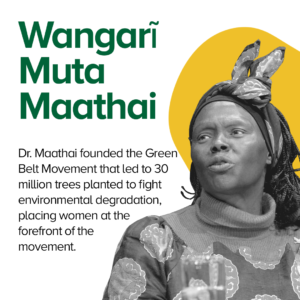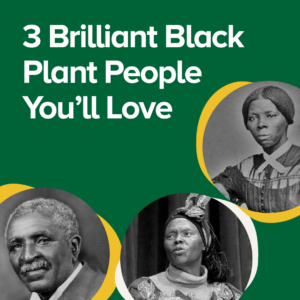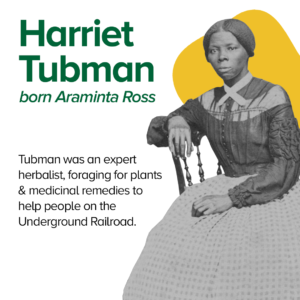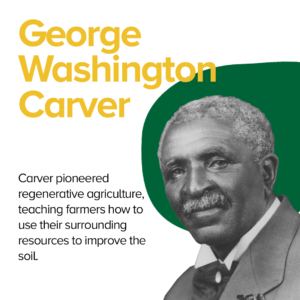For Black History Month, we want to highlight three amazing, historic Black plant people. Two you’ve almost certainly heard of before: Harriet Tubman and George Washington Carver. But did you know that Tubman was an herbalist and Carver spearheaded regenerative agriculture? Our third Black plant person was Wangari Maathai–the very first African woman to receive the Nobel Peace Prize for her environmental, women’s rights, and political work.
This blog is inspired by Episodes 85 and 146 of Bloom and Grow Radio–where host Maria Failla interviewed Colah, host of Black in the Garden Podcast, about figures who inspire her.
Read on to learn more about how these brilliant Black plant leaders contributed to what we know in the plant world today!
1. Harriet Tubman–The Herbalist You Never Knew
You’ve probably heard of Harriet Tubman as being a leader of the Underground Railroad, helping 300 enslaved people escape during the 1800s. On top of all that incredible work during the Civil War, she was also an herbalist, forager, and healer!
One of the main conductor duties of the Underground Railroad was to find nourishment for the many enslaved seeking safe passage. Tubman’s extensive knowledge on foraging was absolutely essential as a conductor. She was taught how to forage for food and herbs in the surrounding forest, learning which plants were safe to eat, and how they could treat ailments. Knowing how to forage for foods like black cherry, paw-paw, and sassafras while avoiding toxic plants no doubt saved the many lives she encountered.
Tubman also used herbal remedies passed down from her grandmother for so many treatments. She boiled cranesbill and lily roots to make medicine for wounded Civil War soldiers, treating things like smallpox, fevers, and other infectious diseases. To keep babies from crying and put them to sleep during treacherous journeys, she dosed their bread with laudanum, a tincture of opium. Tubman learned and practiced herbalism at great costs, as enslavers banned herbal practices from fears of being poisoned.
Harriet Tubman had an understanding of the land–a deep intuitiveness and connection with nature. She was able to really use that to benefit the hundreds of enslaved people she freed.
2. George Washington Carver–Way More Than the Peanut Guy
Yep, you’ve probably heard of George Washington Carver as the Peanut Guy, inventing hundreds of ways to use the humble peanut. But his story is WAY more incredible than that. Let’s dive in.
Regenerative agriculture is a phrase you may have heard thrown around in the plant community, but is nothing new. Regenerative agriculture practices building soil health to offset many environmental problems we face today for future generations of farmers. Carver played a crucial part in regenerating soil in the farming communities of the South. One big way he did that? Peanuts.
Of course it wasn’t JUST peanuts. At that time Carver was working at the Tuskegee Institute as an agricultural research scientist. Soil was horribly depleted from years of cotton and tobacco monoculture farming, and Carver was on a mission to improve the soil and make farming more attainable for poor farmers of the South. Instead of the expensive fertilizers that were being pushed, Carver showed farmers they could use resources all around them to amend the soil. Surrounding woods had biodegradable materials like leaves, logs, and swamp muck–all perfect for in-ground composting that added rich organic nutrients and important microorganisms back into the soil. We truly owe American agriculture and organic farming to Carver, who pioneered much of the important soil and regenerative agriculture knowledge we practice now.
So after teaching farmers how to use their surrounding resources, he wanted to continue building the soil with different nitrogen-fixing crops and crop rotation. In comes the peanut! Legumes, like the peanut and soy bean that Carver encouraged, are nitrogen-fixing plants that restore soil even more. But farmers had to be convinced that these crops could sell–so Carver set off to invent literally hundreds of ways to use peanuts, soy beans, and sweet potatoes in his laboratory. He made biofuel, amazing dyes, milk, butter, oils, cosmetics, and industrial products, just to name a few. He did this for multiple reasons: to make growing these plants profitable to farmers who were often farming on debts to white landowners; to regenerate the soil; and to make a protein-rich crop like peanuts readily accessible to many poor Southerners who couldn’t afford nutrient-dense foods.
Despite being a research scientist, developing hundreds of new products in his lab, and tending to a farm research plot, he didn’t stop there. To make his research more accessible to farmers he was trying to reach, he created mobile agricultural schools called “Farmers Institutes.” These schools literally traveled from town to town via wagon, teaching farmers these regenerative agriculture techniques. It was so successful and popular that the USDA later adopted Carver’s outreach model.
Carver’s work enabled Black farmers to turn their farms into productive, regenerative, and self-sufficient lands to alleviate poverty. What an amazing, trailblazing human!
Check out Colah B. Tawkin’s Black in the Garden two-part podcast series on George Washington Carver, the botanical GOAT, to hear more about Carver.
3. Dr. Wangari Maathai–A Trailblazing Woman Who Planted Millions of Trees
Wangari Maathai was the first African woman to receive the Nobel Peace Prize. But she was also the first woman from East and Central Africa to earn a PhD, moving on to be the first female professor in her home country of Kenya. And those weren’t her only firsts!
Dr. Maathai founded the Green Belt Movement in 1977. This grassroots organization encouraged women to plant trees in their local communities in Africa to fight environmental degradation and deforestation. These women were observing the very real effects of deforestation–receding streams, soil erosion, and habitat loss. Dr. Maathai’s solution not only encouraged trees to combat all these issues, but put women at the center of this incredibly important movement. She didn’t stop there.
Dr. Maathai used her work on the Green Belt Movement to bring attention to the democratic struggle in Kenya. Due to governmental corruption, public lands were being privatized and illegally developed, wreaking havoc on the environment. Dr. Maathai realized she must approach the situation more systematically to address the problem. Her protests were met with harassment and beatings, landing her in jail–but she remained undaunted. She went on to serve on countless international commissions and committees, working tirelessly to fight for women’s rights, environmental issues, against land grabbing, and misogyny.
Her work led to over 50 million trees planted–can you imagine how HUGE that is? That totals to 1 million acres or 1,600 square miles. That’s bigger than Rhode Island! Not only did these trees help the local environments, but they also removed 2.5 million tons of CO2 from the atmosphere. Dr. Maathai’s legacy proves how a single human can be an incredible force for change.
Botanical Black History in the Making
Out of her studies in broadcasting and her love for plants, Colah created the Black in the Garden podcast to highlight Black voices and Black people in horticulture. She is creating a space for Black people to connect with their history and culture through her media.
As Black in the Garden has evolved, Colah’s mission has developed to explore the past, present, and future of Black people in horticulture. Colah herself has just announced an initiative to plant a tree in every state and make history as the first Black woman to do it, inspired by Dr. Wangari Maathai.
Follow her journey on the Black in the Garden podcast.
About Our Interviewee
Colah B. Tawkin is the juggernaut creator, producer, and voice behind the renowned Black in the Garden podcast, a podcast that exists specifically to highlight Black voices and Black people. Using her extensive horticultural knowledge, her endless love for Black people, and her keen ability to teach in a spirit of joy and kinship, she has built a village of Soil Cousins that have come to not only love, but trust her voice. Her aim is to grow and foster village-building, education, and healing through gardening. And she’ll make you laugh while she does it, too.
Her most recent work is the Black in the Garden Coloring Book, featuring podcast guests and 20 pages of illustrated botanical black excellence.
Follow Colah & Black in the Garden:
Harriet Tubman: herbalism, food, foraging
- https://www.botanicgardens.org/blog/representation-botany-and-horticulture-part-2
- https://www.npr.org/sections/thesalt/2016/04/27/475768129/nurse-spy-cook-how-harriet-tubman-found-freedom-through-food
- https://www.nursing.virginia.edu/news/flashback-harriet-tubman-nurse/
- https://theherbalacademy.com/african-american-herbalism-history/
Underground Railroad
George Washington Carver
- https://www.usda.gov/oascr/carver
- https://agriculture.mo.gov/gwc.php
- https://www.cbf.org/blogs/save-the-bay/2021/02/what-we-owe-to-george-washington-carver.html
- https://www.nmhealthysoil.org/2021/01/28/soil-health-pioneer-george-washington-carver/
- https://www.csuchico.edu/regenerativeagriculture/blog/blm-reg-ag.shtml
- https://www.acs.org/content/acs/en/education/whatischemistry/landmarks/carver.html
- https://www.nobelprize.org/prizes/peace/2004/maathai/biographical/
- https://www.un.org/africarenewal/web-features/wangari-maathai-woman-trees-dies
- https://en.unesco.org/womeninafrica/wangari-maathai/biography
- https://wangarimaathai.org/wangaris-story/
The post Botanical Black History: 3 Brilliant Black Plant People You’ll Love first appeared on Espoma.
from Espoma https://www.espoma.com/bloom-and-grow-radio/botanical-black-history/
from
https://summerblakeley.wordpress.com/2022/02/24/botanical-black-history-3-brilliant-black-plant-people-youll-love/



No comments:
Post a Comment